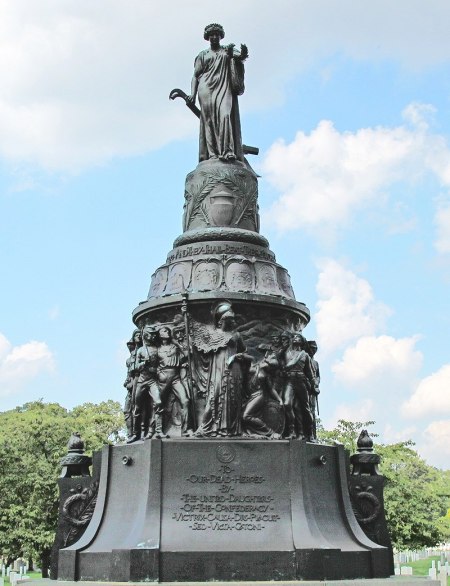Would you believe that confederate statues and monuments actually started as a Woman’s movement? No you will not hear that from MSM or read it in the recent Yahoo column by Matthew Dallek (Yahoo has become a full on liberal state media outlet). There is much in Matthew’s column that is skewed.
Before we start, let me just say that this author cares little about the whole issue. I take the point that the south lost and thus see the argument of why have the monuments standing. On the other hand, it might be elevating to read the inscription on the Confederate Memorial at Arlington National Cemetery.
NOT FOR FAME OR REWARD
NOT FOR PLACE OR FOR RANK
NOT LURED BY AMBITION
OR GOADED BY NECESSITY
BUT IN SIMPLE
OBEDIENCE TO DUTY
AS THEY UNDERSTOOD IT
THESE MEN SUFFERED ALL
SACRIFICED ALL
DARED ALL — AND DIED
For some better insight into the history of the confederate statues and monuments, let us turn from Assoc. Prof. Dallek Graduate School of Political Management to Dr. Sarah Beetham an Assistant Professor of art history at the Pennsylvania Academy of the Fine Arts, specializing in the art of the United States.
In a Public Art Dialogue Newsletter entitled “Confederate Monuments and the Black Lives Matter Movement”, she looks at this tribute history. The first item of note, the article is dated from 2015. This monument removal has been a targeted attack from BLM for some time. One wonders just how much theater was involved at Charlottesville and the actions post event.
Referencing back to Prof. Dallek’s Yahoo article:
“It is remarkable that scores of monuments and statues to the Confederacy, the losing side in the Civil War, were even erected in the first place.”
The Public Art Dialogue Newsletter starts with the following entrance:
“Countries around the world, from Syria to Spain to Argentina, have grappled with the bronze and stone sculptural legacy of leaders who represent a dark chapter in their nation’s past.”
In Prof. Dallek’s Yahoo article he continues:
“As historians and journalists have amply documented, the first wave of statues and monuments were erected decades after North had won the Civil War.”
Dr. Beetham seems to clearly contradict this:
“Confederate monuments began appearing in Southern states within the first decade after the Civil War.”
She furthers goes on to explain why this initial wave was limited in scope:
“At first, they did not appear as frequently as their Union counterparts for two key reasons: in the war-torn South, available resources went first toward rebuilding cities and infrastructure destroyed during the war, and in the Reconstruction era, when former Confederates had to swear an oath to support the United States in order to retain citizenship rights, it was politically tricky to erect monuments in open support of Confederate ideals.”
Dr. Beetham continues:
“Another factor to keep in mind is that most Southern states did not have the manufacturing resources to produce fine art sculpture for monuments, and so most public art was imported. Marble statuary came from Italy, and bronze sculpture was often cast in Germany. But many Southerners also procured their statues of Confederate soldiers from Northern companies that marketed inexpensive stock figures through catalogues.”
Prof. Dallek’s article expresses the notion that a larger wave of monuments is directly related to segregationists:
“As the South in the 1890s and 1900s began to codify segregationist Jim Crow laws and deployed mob and state-sanctioned violence to keep African-Americans subjugated, states erected dozens of public tributes to the cause of the Confederacy.”
Dr. Beetham has a different explanation:
“More and more Confederate monuments began to appear as the Reconstruction era drew to a close and Southern states began to regain their economic power. The Spanish-American War also played a role, as soldiers from the North and the South united in a common cause. Thus, the peak years for the appearance of Confederate monuments ranged from the mid-1880s to about 1920.”
One item I did not read in Prof. Dallek’s article that was a surprise read in Dr. Beetham article:
“Most of these monuments were sponsored by local women’s groups, first dubbed Ladies’ Memorial Associations, and by the 1890s, local chapters of the United Daughters of the Confederacy. As Southern women did not have to swear an oath of loyalty to the United States and were barred from participating in government because of their gender, they were free to engage in political speech that would have been hazardous for their male counterparts.”
Oh no – now what do the SJW’s do?
As I said before, I am not as invested in this debate as others. What I am sick of is biased news coverage and reporting. It is so easy to slant news. For example, I could have stopped here with quoting Dr. Beetham. However, she did also say the following regarding the local women’s groups:
“They were able to cloak their memorial activities in the language of grief and domesticity, claiming that the monuments they erected were solely intended to honor the dead. These memorial associations raised the funds for monuments through private donations and local fairs or other events, and many of the monuments remain under the control of the United Daughters of the Confederacy or local laws.”
To me… and maybe just to me, Dr. Beetham’s words read as honest facts and Prof. Dallek’s read as agenda driven. In my opinion, the mainstream media (MSM) has become very dangerous. I truly mean dreadfully dangerous. That very large MSM organic culture represents only one view of a nation divided. This article has run long, so I will not delve into the parallels related to the societal times of the Civil War, but as George Santayana noted:
“Those who cannot remember the past are condemned to repeat it.”
This is worthy of your time, relating to the undercurrent of the above article:
[youtube https://www.youtube.com/watch?v=FOZ0irgLwxU]
